“Redevelopment is harder than development so we needed to make our regulations more flexible and offer developers more options than just building stormwater ponds that take up valuable space,” she said.
The regulations, which are still pending approval but have strong support from both the development community and the board of county commissioners, look at a wide variety of options to meet new stormwater standards, she adds. Rather than the typical “x number of square feet of impermeable surface equals x cubic feet of retention pond storage,” developers must reach a certain number of points using the detailed system that’s part of the manual.
The alternatives range from maintaining current tree cover – which captures nutrients and reduces runoff – to swales and berms that hold stormwater without requiring as much land as a standard retention pond and even innovative technologies such as green roofs and managed aquatic plant systems.
“That doesn’t mean developers can’t do everything the way they’ve always done it,” Levy emphasizes. “It just gives them a series of options that often work out to be less expensive in the long run – particularly when they count the value of the land they’ve been able to build on instead of creating a large retention pond.”
To develop the manual, Pinellas County brought together a team of experts from across the state, including Clark Hull, former environmental resource permitting program manager at the Southwest Florida Water Management District; Eric Livingston, former director of the Florida Department of Environmental Protection’s Bureau of Watershed Management; and Marty Wanielista, former executive director of the Stormwater Management Academy at the University of Central Florida.
Much of it is based upon work begun by the Florida Department of Environmental Protection in the mid-2000s under Livingston’s direction, but largely abandoned when the recession brought development to a halt. With construction rebounding, local governments with surface waters identified as “impaired” must meet new standards for nutrients and other pollutants in stormwater under the federal Clean Water Act.
Nearly all of Pinellas County’s waters are listed as impaired, so new development as well as redevelopment must reduce nutrients in runoff by 10%, Levy adds. “It’s not a lot individually, but over time, we’ll see a significant impact.”
The technologies, often called low-impact development or LID, typically work together in a “treatment train” that focuses on holding stormwater onsite as long as possible to minimize both flooding and nutrient release within the watershed, Hull notes. “It’s highly unlikely that one BMP (best management plan) will meet the entire stormwater goal but they work together.”
For instance, a stormwater pond may meet part of the goal, with a managed aquatic plant system or stormwater harvesting program also reducing pollutants and volume of discharge. Another option may be a filter at the pond’s discharge to reduce nutrients even further.
Commercial redevelopment can use parts of their parking lots and green space requirements to meet their stormwater goals as well, Hull adds. “One of the easiest things developers can do is create a dip in the parking median rather than raising it. It’s even less expensive than curbing and building it up but it holds water on the site.”

A perfect example is the parking lot at the Florida Aquarium in downtown Tampa where native plants thrive in swales constructed between parking areas. A newer example is Rumba Island Bar and Grill in Clearwater where cypress trees grow in interconnected swales that serve as a very attractive but long and narrow retention pond.
“The goal of the manual is to provide enough guidance to a developer so they can identify which technologies work best with a particular piece of property and expect to move through the approval process as quickly as possible,” Hull adds.
To make it even easier, the manual also incorporates other sections of the county’s land development code including open space and landscape regulations so developers can “double-dip” to save land, adds Levy. “That makes saving a large oak tree more appealing, even if you have to build a road around it. It takes decades to replace some of the trees that are being mowed down now.”
Much of Pinellas was built out shortly after World War II – long before the state enacted stormwater rules – so the primary goal was to move water out fast to prevent flooding. In some neighborhoods, that created ditches that drain straight to creeks, lakes, Tampa Bay or the Gulf. “We need to make redevelopment to today’s standards not so expensive that a developer just walks away,” Levy said.
As other counties recognize the extremely expensive costs of cleaning up stormwater once it’s released, both Levy and Hull expect the Pinellas County manual to become a prototype for other cities and counties across the state. “Many of the cities in the county already are on board with the new regulations, too,” Levy said. “We think it’s a win-win for everyone involved.”
[su_divider]